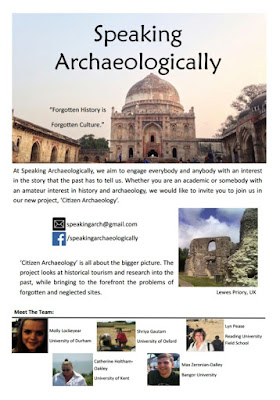Dawn Of Citizen Archaeology and SA Volunteers: A Speaking Archaeologically Initiative by Shaurya Dahiya
 In our last post, you read how an idiosyncratic Panel of five archaeologists started posting their
findings on the Facebook page Speaking Archaeologically, drawing interested people and parties from all over the world.
In our last post, you read how an idiosyncratic Panel of five archaeologists started posting their
findings on the Facebook page Speaking Archaeologically, drawing interested people and parties from all over the world.
Today's post is about what happened next!
Within two months of its inception, the Panelists began to receive invites and emails from several amateurs and professionals to visit new towns and cities, with lost archaeological stories and historical anecdotes, so that, they could include them on the Global Archaeological Map.
Travelling to all these sites was, however, impossible for the Panel. Long journeys, international flights and brain wracking archaeological work is not easily done, especially when one has to rely on personal finances for the work, after all!
This gave birth to Phase II of Speaking Archaeologically: something the Panelists christened Citizen Archaeology.
Drawing inspiration from the Citizen Science App, the Panelists encouraged the
people around the world to email them pictures of anything "forgotten" and "historical" and once again, the response was overwhelming.
Shriya Gautam would tell you she was pleasantly surprised that a platform like this was a virgin territory in archaeology.
"I honestly expected something like this must have been done somewhere before but it was precisely because it hadn't been done before and because of the response we received,that we decided to call the youth of the
world to action."
That's when in Chandigarh, where Shriya happened to be at the moment, two leading Humanities and Arts colleges were chosen from a list of over twenty institutions in the vicinity and Seminars were held to acquaint the students with Citizen Archaeology..
"The gleaming
eyes of the students and the inquisitive minds of those kids got to me," Shriya remembers. " So many of them wanted to learn more about archaeology, engage in any way possible but there's simply so little going around here, that no one ever finds out!"
That was when a few handpicked Volunteers were taken in and were given the task to write research papers. The best ones were supposed to be rewarded.
That was when a few handpicked Volunteers were taken in and were given the task to write research papers. The best ones were supposed to be rewarded.
"I figured that if we couldn't really bring a site for them to dig in, there was still visual culture and object analysis to be done. Also, what a very few people know about archaeology is how to write something of substance based on your study or finds about any particular site anywhere in the world. This was what I was going to teach these kids: the Art of Archaeological Research."
Five Volunteers were chosen based on their response at the seminars, Ten more joined in simply by word of mouth when their colleges talked about what was going on at Speaking Archaeologically. For the first task, these fifteen people were divided into three teams and were supposed to write on some fairly well known sites from Egypt, Lebanon, China and Turkey: something the internet could have helped them find. Understandably, the Panel didn’t let its expectation sky rocket. These kids had never written a research paper before. However, when the papers were finally turned in the team was in for a surprise!
The details with which the Volunteers had researched on their topics exceeded the Panel's expectations.
Over the next few weeks, guidelines were issued for writing research papers and reading extensively, with special attention to the value of originality, especially when it came to conclusions. The Volunteers could freely contact the Panel any time with any doubts or questions and the Panel was always there.
"Their words not ours: we were often asked, in overawed tones whether we Panelists slept at all."
"They weren't just good, they were brilliant! And they were passionate! If you know me, you'd know I thrive on passion and that's exactly why we decided to raise the bar for these kids."
Over the next few weeks, guidelines were issued for writing research papers and reading extensively, with special attention to the value of originality, especially when it came to conclusions. The Volunteers could freely contact the Panel any time with any doubts or questions and the Panel was always there.
"Their words not ours: we were often asked, in overawed tones whether we Panelists slept at all."
 |
| The Volunteers at an SA Workshop in Chandigarh, presided over by Shriya Gautam |
The number of volunteers has now reached to a whooping 20 young students between the ages of 17-21 years. The
interest of the general public and the dedication of the Panel surely
does make it something worth probing into.
So, as you follow SA's professional research on Facebook, Twitter and Google+, don't forget to keep up to date on our blog, where we provide you an exclusive sneak-peek into the travel diaries of our Panelists and Volunteers and the inside stories from the Workshops and lectures.



Comments
Post a Comment